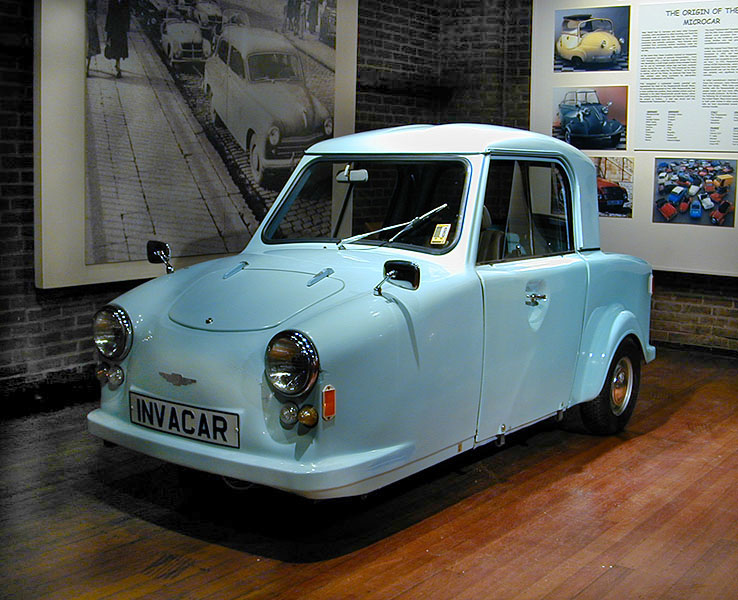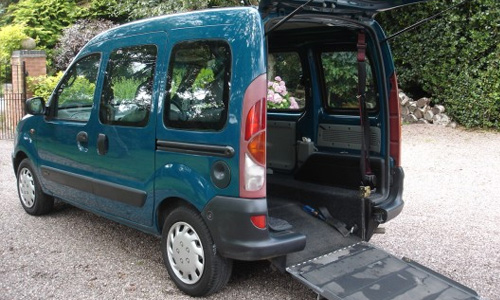Back in the past,disabled people were often seen driving, alone, in an unflattering yet classic and often remembered three-wheeled vehicle – the invalid carriage.
(1953 Thundersley Invacar.)

But 30 years ago that all changed, with the UK built.
1960’s AC Invacar.

They are motorised trikes with a fibreglass shell designed for driving on the road – a kind of one-person car which made disabled people more mobile.
Known generically as the Invacar, this was actually the brand name of one of the models available – the light blue Thundersley or AC Invacar which are the ones people remember most. Not overly stylish, even their own drivers referred to them as “Noddy cars”.
But I haven’t seen one for ages… Ready for scrap!

You won’t have done. On 31 March 2003, they were banned from use on roads in the United Kingdom because of safety concerns. They were all called in and crushed, though a few survive in museums and private ownership.
After the war and in the caring rosy glow around the beginnings of the NHS, it was felt something was needed to get injured ex-servicemen and disabled people more mobile.
In 1946 the first accessible motor-driven trike was invented by engineer Bert Greeves for his paralysed cousin. Greeves then founded the Invacar company.
The Ministry of Health subsequently started a service where they supplied and repaired these motorised tricycles, giving them free of charge to those who were eligible.
They were accessible vehicles designed for just one person. They used tillers instead of a steering wheel, were high up, had a space to stow a folding wheelchair away and were easy to get into.
A handful of models were made over this period and varied in speed from 40 to 82mph. They were based on motorbike technology and driven by a chain.
Good question – it does sound extraordinary nowadays that the NHS made and maintained a fleet of road vehicles for disabled people. The government didn’t see these as cars… they saw them as a prosthetic.
Sir Bert Massie, a governor for the modern day accessible car scheme Motability, explains that those in charge didn’t think of it as a service that gave you independence through motor vehicle ownership:
“The government didn’t see these as cars… they saw them as a prosthetic. There was a strange logic to their thinking. They saw the role of the NHS as being there to get you mobile. If you were not disabled, you’d be doing that with your legs. So, if you were disabled, and couldn’t do that, they gave you a one-person invalid carriage as a leg replacement to get you from A to B.”

Massie got his first trike after taking something very unlike a comprehensive exam at 16. Rather than going to a garage or driving school, he had to show up at an artificial limb appliance centre at a hospital in Liverpool. There, he met an assessor with an invalid carriage.
“The guy who assessed me was an engineer and he said: ‘Sit in this, I’m going to push you and I want you to push the brake down to see if you can stop.’ So we did that, I stopped it and he said, ‘Right, you’re quite capable of driving’ – and that’s how I passed my test.”
By the time they announced the closure of the scheme in 1976, there were 21,500 invalid carriages in use around the country.
For a number of years, governments had been put under pressure from disability campaigners who felt the one-person cars were unhelpfully antisocial. If you were a mum or dad, for instance, you were not able to drive your children to school.
The scheme was meant to close totally in 1981 but some people really liked their invalid carriages and kept on using them until the outright ban in 2003.
Rather than providing free vehicles, cash schemes like the mobility allowance and Motability gradually took over in the 1970s, allowing you to buy and adapt a mainstream car. More than 600,000 people presently take advantage of the Motability scheme and gain independence as a result.
Maintenance of the cars had become difficult and the ministry declared them unsafe.
“I’ve got a personal friend who used to drive one across the moors in Yorkshire,” says Jim Rawlings, archivist for Disabled Motoring UK. “He had to carry half a sack of King Edwards to weigh it down because it was so susceptible to crosswinds.”
Bert Massie adds: “I had a few go on fire on me, so you’d stop and other motorists would drag you out as the thing went up in flames.”

AC Invalid Carriage in action!
Notice how tall vehicles are, latest cars have lowered floors, so normal roof height.

GOWRINGS CHAIRMAN METRO.1975

GOWRINGS CHAIMAN ESCORT.1990.


The base cars were getting better, and the conversions more refined.
The next step forward in 2004,was by “Allied Mobility”, with the five seat mode.

The latest innovation is the fold flat ramp, as shown on this 2011 Allied Peugeot Partner Horizon.

We love to buy & sell used wheelchair cars. Part Exchange Available. Canterbury showroom with keen prices -or- I can come to you!